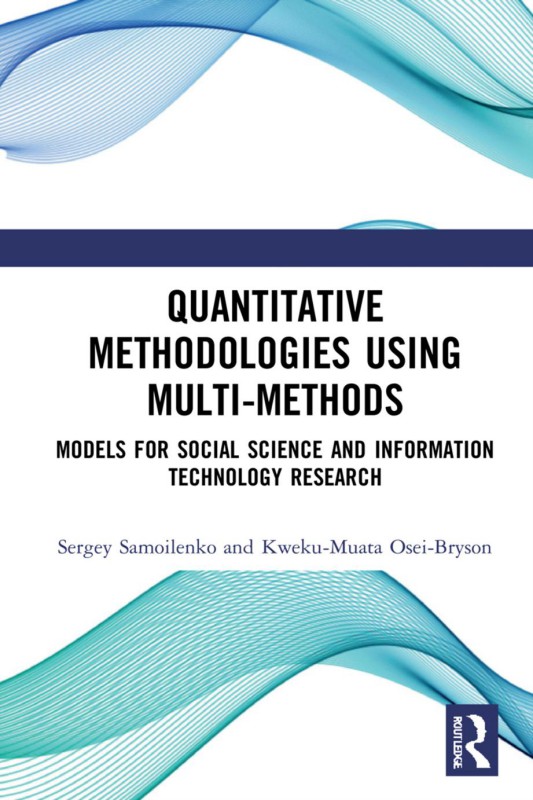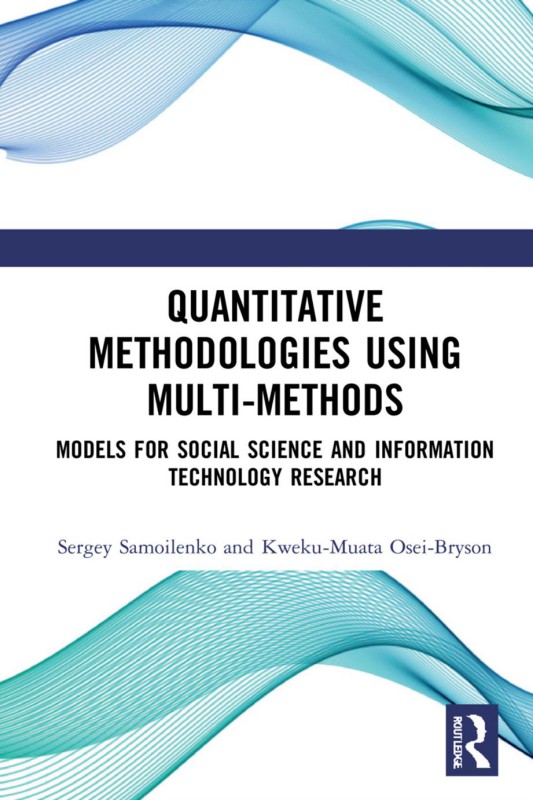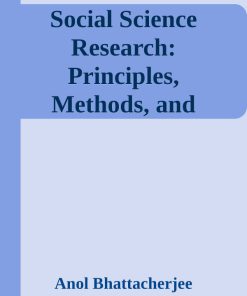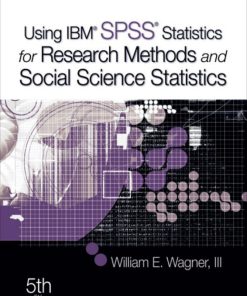Quantitative Methodologies using Multi Methods Models for Social Science and Information Technology Research 1st edition by Sergey Samoilenko, Kweku Muata Osei Bryson 9781000431131 1000431134
$50.00 Original price was: $50.00.$25.00Current price is: $25.00.
Authors:Sergey V. Samoilenko , Series:IT & Computer [115] , Tags:ocial Science › Research Business & Economics / Research & Development Social Science / Research Technology & Engineering / Research , Author sort:Samoilenko, Sergey V. , Ids:DOI , Languages:Languages:eng , Published:Published:Mar 2022 , Publisher:Routledge , Comments:Comments:Written for researchers engaged in quantitative non-parametric investigations, particularly in the area of Information and Communication Technology for Development (ICT4D), the book discusses multi-method methodologies based on the building-block design. Application of the methodologies is illustrated by research into ICT4D in Sub-Saharan Africa.
Quantitative Methodologies using Multi Methods Models for Social Science and Information Technology Research 1st edition by Sergey Samoilenko, Kweku Muata Osei Bryson – Ebook PDF Instant Download/Delivery. 9781000431131, 1000431134
Full download Quantitative Methodologies using Multi Methods Models for Social Science and Information Technology Research 1st edition after payment

Product details:
ISBN 10: 1000431134
ISBN 13: 9781000431131
Author: Sergey Samoilenko; Kweku-Muata Osei-Bryson
Quantitative Methodologies using Multi Methods Models for Social Science and Information Technology Research 1st Table of contents:
SECTION I Development of the Methodological Modules
Chapter 1 Pre-Requisite General Questions
Impact of the Assumption of Homogeneity of the Sample on Research Questions
From a Basket of Apples to a Set of Systems (Decision-Making Units)
From Systems to Systems in Context
Chapter 2 Components of Multi-Method Methodologies
Cluster Analysis (CA)
Classification Decision Trees Induction (CDTI)
Neural Networks (NNs)
Association Rules Mining (ARM)
Data Envelopment Analysis (DEA)
Multiple Regression (MR)
Chapter 3 Framework for Methodological Modules
SECTION II Description of the Methodological Modules
Chapter 4 A1: Homogeneous Sample – DEA and DTI
Phase 1: DEA
Phase 2: DTI
Examples of Application of DEA and DTI
Chapter 5 A2: Homogeneous Sample – DEA and ARM
Phase 1: DEA
Phase 2: ARM
Examples of Application of DEA and ARM
Chapter 6 B1: Heterogeneous Sample (Groupings Are Given) – DTI and ARM
Phase 1: DTI
Phase 2: ARM
Examples of Application of DTI and ARM
Chapter 7 B2: Heterogeneous Sample (Groupings Are Given) – DTI and MR
Phase 1: DTI
Option 1: DTI Using the Data Set Comprised of a Causal Model Only
Option 2: DTI Using the Data Set without Causal Model
Option 3: DTI Using the Complete Data Set
Phase 2: MR
Option 1: MR Using the Causal Model Only
Option 2: MR Using the Adapted Causal Model – Contextual Independent Variable
Option 3: Creating a New MR Using Contextual Independent Variables
Example of Application of DTI and MR
Chapter 8 B3: Heterogeneous Sample (Groupings Are Given) – DTI, DEA, and ARM
Phase 1: DTI
Option 1: The Data Set Is Comprised of the Variables of the DEA Model
Option 2: The Data Set Contains Contextual Variables
Phase 2: DEA
Phase 3: ARM
Option 1: ARM to Generate “If→ (Level of the Top-Split Variable(s))”
Option 2: ARM to Generate “If→ (DEA Model’s Inputs)”
Option 3: ARM to Generate “If→ (DEA Model’s Outputs)”
Option 4: ARM to Generate “If→ (Level of Averaged Relative Efficiency)”
Option 5: ARM to Generate “If→ (Received Categorization)”
Examples of Application of DTI, DEA, and ARM
Chapter 9 B4: Heterogeneous Sample (Groupings Are Given) – DTI, DEA, and NN
Phase 1: DTI
Phase 2: DEA
Phase 3: NN
Step 1: Generate NN Model of Transformative Capacity
Step 2: Generate Outputs of a Less Efficient Group Based on Transformative Capacity of a More Efficient Group
Step 3: Generate Outputs of a More Efficient Group Based on Transformative Capacity of a Less Efficient Group
Step 4: Compile the Generated Outputs in a New Data Set
Phase 4: DEA
Example of Application of DTI, DEA, and NN
Chapter 10 C1: Heterogeneous Sample (Groupings Are Not Known) – CA and DTI
Phase 1: CA
Phase 2: DTI
Examples of Application of CA and DTI
Chapter 11 C2: Heterogeneous Sample (Groupings Are Not Known) – CA and ARM
Phase 1: CA
Phase 2: ARM
Option 1: ARM Using Only Intrinsic Variables
Option 2: ARM Using Only Contextual Variables
Option 3: ARM Using Intrinsic and Contextual Variables
Examples of Application of CA and ARM
Chapter 12 C3: Heterogeneous Sample (Groupings Are Not Known) – CA, DTI, and MR
Phase 1: CA
Phase 2: DTI
Option 1: Data Set Is Limited to Variables of the MR Model
Option 2: Data Set Comprises Variables of the MR Model and Contextual Variables
Phase 3: MR
Example of Application of CA, DTI, and MR
Chapter 13 C4: Heterogeneous Sample (Groupings Are Not Known) – CA, DTI, and ARM
Phase 1: CA
Phase 2: DTI
Option 1: A Priori Target Variable
Option 2: CA-based Target Variable
Phase 3: ARM
Step 1
Step 2
Step 3
Step 4
Examples of Application of CA, DTI, and ARM
Chapter 14 C5: Heterogeneous Sample (Groupings Are Not Known) – CA and DEA
Phase 1: CA
Option 1: CA based on the DEA Model
Option 2: CA based on the DEA Model and Contextual Variables
Phase 2: DEA
Examples of Application of CA and DEA
Chapter 15 C6: Heterogeneous Sample (Groupings Are Not Known) – CA, DEA, and ARM
Phase 1: CA
Phase 2: DEA
Phase 3: ARM
Option 1: Complete Sample, # of Variables = the DEA Model
Option 2: Complete Sample, # of Variables = the DEA Model + Contextual Variables
Option 3: Sub-Sets of the Sample, # of Variables = the DEA Model
Option 4: Sub-sets of the Sample, # of Variables = the DEA Model + Contextual Variables
Examples of Application of CA, DEA, and ARM
Chapter 16 C7: Heterogeneous Sample (Groupings Are Not Known) – CA, DTI, and DEA
Phase 1: CA
Phase 2: DTI
Phase 3: DEA
Examples of Application of CA, DTI, and DEA
Chapter 17 C8: Heterogeneous Sample (Groupings Not Known) – CA, DTI, DEA, and NN
Phase 1: CA
Phase 2: DTI
Phase 3: DEA
Phase 4: NN
Step 1: Creating an NN Model of “Low-Level” Cluster
Step 2: Creating an NN Model of “High-Level” Cluster
Step 3: Simulation of the Outputs of “Low-Level” Cluster Using NN Model of “High-Level” Cluster
Step 4: Simulation of the Outputs of “High-Level” Cluster Using NN Model of “Low-Level” Cluster
Phase 5: DEA
Examples of Application of CA, DTI, DEA, and NN
SECTION III Methodological Modules – Examples of Their Application
Chapter 18 A Hybrid DEA/DM-based DSS for Productivity-Driven Environments
Introduction
Description of the DSS
Externally Oriented Functionality
Internally Oriented Functionality
Architecture of the DSS
An Illustrative Application
Step 1: Is the Business Environment Homogeneous?
Step 2: What Are the Factors Responsible for Heterogeneity of the Business Environment?
Step 3: Do Groups of Competitors Differ in Terms of the Relative Efficiency?
Step 4: What Are some of the Factors Associated with the Differences in Relative Efficiency?
Step 5: Are There any Complementarities Between the Relevant Variables?
Step 6: What Is a Better Way to Improve Production of Outputs?
Conclusion
Acknowledgment
References
Chapter 19 Determining Sources of Relative Inefficiency in Heterogeneous Samples: Methodology Using Cluster Analysis, DEA, and Neural Networks
Introduction
Description of the Methodology
Description of Steps 3–5 of the Methodology
Step 3: Generate a “Black Box” Model of Transformative Capacity of Each Cluster
Step 4: Generate Simulated Sets of the Outputs for Each Cluster
Step 5: Determine the Sources of the Relative Inefficiency of the DMUs in the Sample
Motivation for Steps 3 and 5 of the Methodology
Motivation for Step 3
Motivation for Step 5
Illustrative Example
Description of the Illustrative Data Set
Application of the Methodology on the Illustrative Data Set
Results of Step 1: Evaluate the Scale Heterogeneity Status of the Data Set
Results of Step 2: Determine the Relative Efficiency Status of Each DMU
Results of Steps 3 and 4: Generate Simulated Sets of the Outputs for Each Cluster Based on Black Box Models Transformative Capacity Processes
Results of Step 5
Discussion and Conclusion
Acknowledgment
References
Chapter 20 Exploring Context Specific Micro-Economic Impacts of ICT Capabilities
Introduction
Theoretical Framework and the Research Model
The Methodology of the Study
Phase 1: Application of Data Envelopment Analysis (DEA)
Phase 1, Step 1
Phase 1, Step 2
Phase 1, Step 3
Phase 2: Decision Tree-Based Analysis
Phase 2, Step 1
Phase 2, Step 2
Description of the Data
Results of the Data Analysis
Results from Phase 1: Application of Data Envelopment Analysis (DEA)
Phase 1, Step 1
Phase 1, Step 2
Phase 1, Step 3
Results from Phase 2 – Decision Tree (DT) Based Analysis
Conclusion
Contributions to Theory
Contributions to Practice
Acknowledgment
References
Chapter 21 A Methodology for Identifying Sources of Disparities in the Socio-Economic Outcomes of ICT Capabilities in SSAs
Introduction
Research Framework
Proposed Methodology
A New Methodology: Benefits and Justifications
Phase 1: Data Envelopment Analysis (DEA)
Phase 2: Decision Tree Induction (DTI)
Phase 3: Association Rule Mining (ARM)
Research Questions and Null
People also search for Quantitative Methodologies using Multi Methods Models for Social Science and Information Technology Research 1st:
quantitative methodologies examples
quantitative methodologies
quantitative research models
quantitative modelling examples












